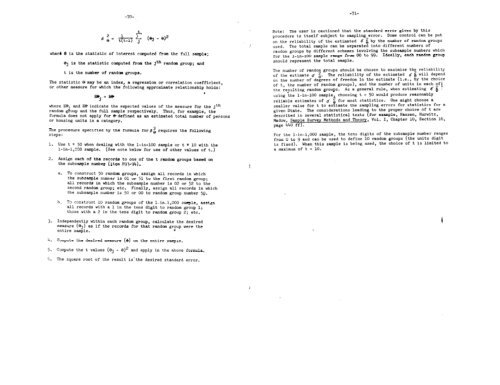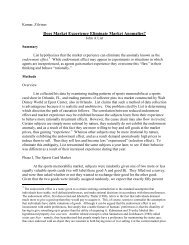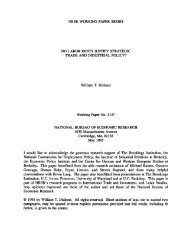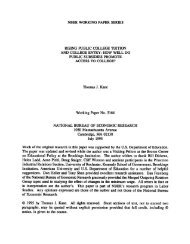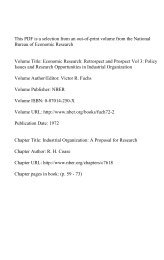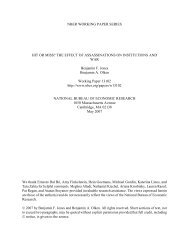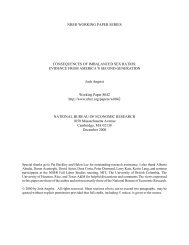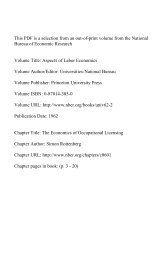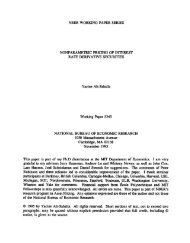Census of Population and Housing, 1960 Public Use Sample ...
Census of Population and Housing, 1960 Public Use Sample ...
Census of Population and Housing, 1960 Public Use Sample ...
Create successful ePaper yourself
Turn your PDF publications into a flip-book with our unique Google optimized e-Paper software.
-7o-<br />
d= +ciJ j<br />
2 (b - a2<br />
wher& 8 is the statistic <strong>of</strong> interest canputed from the full sample;<br />
I~J is the statistic computed from the jth r<strong>and</strong>om group; <strong>and</strong><br />
t is the number <strong>of</strong> r<strong>and</strong>aa groups.<br />
The statistic emay be an index, a regression or correlation coefficient,<br />
or other measure for hich the following approximate relationship holds:<br />
,<br />
Esj = Ee<br />
where EeJ <strong>and</strong> E&indicate the expected values <strong>of</strong> the measure for the jth<br />
r<strong>and</strong>om group <strong>and</strong> the full sample respectively. Thus, for example, the<br />
formula does not apply for &defined as an estimated total number <strong>of</strong> persons<br />
or housing units in e category.<br />
The procedure specified by the formula ford; requires the following<br />
steps:<br />
1. <strong>Use</strong> t = 50 when dealing with the l-in-100 sample or t = 10 with the<br />
l-in-l,%0 sample. (See note below for use <strong>of</strong> other values <strong>of</strong> t.)<br />
2. Assign each oh the recorda to one <strong>of</strong> the t r<strong>and</strong>om groups based on<br />
the subsample nunbe* (item H93-94).<br />
a. To construct 50 r<strong>and</strong>om groups, assign all records in which<br />
the subsample number is 01 or 51 to the first r<strong>and</strong>om group;<br />
all records in which the subsample number is 02 or 52 to the<br />
second r<strong>and</strong>om group; etc. Finally, assign all records in tiich<br />
the subsample number is 50 or CO to r<strong>and</strong>om group number 59.<br />
b. To construct 10 r<strong>and</strong>om groups <strong>of</strong> the l-in-l,000 sample, assign<br />
all records with a 1 in the tens digit to r<strong>and</strong>om group 1;<br />
those with 8 2 in the tens digit to r<strong>and</strong>om group 2; etc.<br />
3. Independently within each r<strong>and</strong>om group, calculate the desired<br />
measure (@J) as if the recorda for that r<strong>and</strong>an griup were the<br />
entire sample.<br />
4. Compute the desired measure (a) on the entire sample.<br />
5. Compute the t values (BJ - e)' <strong>and</strong> apply in the above formula.<br />
'3. The square root <strong>of</strong> the result is'the desired st<strong>and</strong>ard error.<br />
-7l-<br />
Note: Ihe user is cautioned that the st<strong>and</strong>ard error given by this<br />
procedure is itself subject to sampling error. Some control can be put<br />
on the reliability <strong>of</strong> the estimated 6 $ by the number <strong>of</strong> r<strong>and</strong>om groups<br />
used. The total sample can be separated into different numbers <strong>of</strong><br />
r<strong>and</strong>om groups by different schemes involving the subsample numbers which<br />
for the l-in-100 sample range frCT0 OCl to 99. Ideally, each r<strong>and</strong>om group<br />
should represent the total sample.<br />
The number <strong>of</strong> r<strong>and</strong>o? groups should be chosen to maximize the reliability<br />
<strong>of</strong> the estimate 0' The reliability <strong>of</strong> the estimated 6 6 will depend<br />
on the number <strong>of</strong> degrees <strong>of</strong> freedom in the estimate (i.e., by the choice<br />
<strong>of</strong> t, the number <strong>of</strong> r<strong>and</strong>om groups), <strong>and</strong> the number <strong>of</strong> units in each <strong>of</strong>i<br />
the re,sulting r<strong>and</strong>om groups. As a general rule, when estimating d 8<br />
using the l-in-100 sample choosing t = 50 would produce reasonably<br />
reliable estimates <strong>of</strong> 6 i,for most statistics. One might choose a<br />
smaller value for t to es Imate the sampling errors for statistics for a<br />
given State. The considerations leading to the proper choice <strong>of</strong> t are<br />
described in several statistical texts (for example, Hansen, HurWitz,<br />
Madow, <strong>Sample</strong> Survey Methods <strong>and</strong> Theory, Vol. I, Chapter 10, Section 16,<br />
page 440 ff).<br />
For the l-in-l,000 sample, the tens digits <strong>of</strong> the subsample number ranges<br />
from 0 to 9 <strong>and</strong> can be used to define 10 r<strong>and</strong>om groups (the units digit<br />
is fixed). When this sample is being used, the choice <strong>of</strong> t is limited to<br />
a maximum <strong>of</strong> t = 10.


